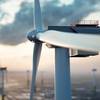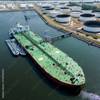Subsidy-Reliant Offshore Wind Takes Cue from Big Oil
From a helicopter, it looks like just another North Sea oil rig, a grey cube supported by massive yellow pillars, 90 kilometres (56 miles) off western Denmark.
But the DanTysk facility is the world's first accommodation platform for offshore wind, which is borrowing techniques and labour from the crisis-hit oil sector as it tries to cut costs and end an addiction to state subsidies.
The wind industry is moving further offshore and into the deeper waters tamed long ago by oil companies to increase scale and capture stronger and more constant winds.
"There's a lot of new-generation technology in the offshore wind industry, but when I'm out there, I still know the nuts and bolts," said Anders Noer Christensen, a former superintendent engineer on oil platforms, who now works as a development manager for Vattenfall's wind projects in the North Sea.
The 100-million-euro ($110 million) DanTysk opened in August as a way to slash operational and transport costs for the remote turbines. Many of its staff used to work in oil or gas until a plunge in crude prices caused a slump in exploration.
Drawing on a classic offshore oil work schedule, up to 50 staff work two weeks on and two weeks off the platform to keep the 80 wind turbines operational. When winds are blowing strong, DanTysk's maximum 280 megawatts can power up to 400,000 homes.
DONG Energy, the world's biggest offshore wind farm operator, says it has halved its wind energy production costs in four years.
The company has found a cheaper and simpler way to fix the turbines in place, which used to involve hammering a steel tube into the seabed. New turbines now have three legs that stand on top of giant suction buckets that anchor the foundation to the seabed. The method has been used in the oil and gas industry since the early 1980s.
Jeppe Lauridsen, a geologist who used to work for DONG Energy's oil and gas unit, is now responsible for finding the right parts of the seabed to site wind turbines.
"Seismic profiles of the underground are used in both (DONG's oil and offshore wind) divisions," he said. "In wind we look at the top 100 metres whereas in oil and gas you look at layers five kilometres deep," he said.
ROCK DUMPING
Danish consultancy Ramboll has installed more than half of the world's offshore turbine foundations, and relies a lot on its experience in oil and gas.
"It's no secret that the oil and gas industry has had a hard time, so thankfully we've been able to use oil and gas staff in offshore wind... There are lots of similarities," said its global market director Soren Petersen.
He said offshore oil equipment companies including Boskalis, Heerema, Seaway Heavy Lift and DEME were looking to shift into offshore wind. Van Oord is using several of its rock-dumping and dredging vessels in both offshore oil and wind, either for laying cables or protecting turbine foundations by covering the surrounding seabed with rocks.
Oil workers are bringing other skills with them, from safety expertise to software design and techniques to extend the life of assets. Dolf Elsevier van Griethuysen of Van Oord's wind division said the oil sector downturn had made tenders to build offshore installations more competitive and lowered prices.
The UK oil and gas industry lost 110,000 jobs between 2013 and 2016, according to industry lobby Oil & Gas UK. The offshore wind industry employs over 13,000 people in Britain and has the potential to provide 44,000 jobs in the next 10 years, said RenewableUK, another industry body.
"When oil prices were still high, competition for talent was a big headache for the wind industry, because we simply couldn't pay the same salaries. But that has significantly changed," said Martin Neuberts, DONG Energy's chief strategy officer.
DASH FOR SCALE
DONG Energy said in September it would build the UK's largest offshore wind maintenance hub in northeast England to service its offshore wind farms. On the Essex coast of eastern England, it repurposed Europe's biggest drilling rig to help lay power cables to connect offshore wind farms with the main grid.
As the onshore business' younger sibling, offshore accounts for only 8 percent of Europe's total installed 142 gigawatt wind capacity, which covers 11 percent of EU electricity demand.
Many European governments are keen for that percentage to rise after they led the way in developing offshore wind. But few of the continent's cash-strapped governments have given firm plans for support beyond 2020.
Developers need to keep costs tumbling for it to have a future. The key to that is dependable government support and continued rapid expansion: 4-7 GW of new capacity is needed each year to bring costs below 80 euros per MWh from around 125 euros now, according to the industry.
Coal is still the cheapest energy source at between 50 and 90 euros per megawatt hour, according to industry group WindEurope. But advocates of offshore wind say it is already proving it can kick its addiction to state subsidies.
A little over a year after winning a 400 MW order for Horns Rev 3 in the Danish North Sea at a production price of 103.1 euros per megawatt hour, Vattenfall won a Danish near-shore project in September by promising to produce power at 63.8 euros per megawatt hour. Just last week, Vattenfall won the 600 MW Kriegers Flak project by bidding to produce power at a record 49.9 euros per megawatt hour. The company aims to build subsidy-free offshore wind by 2025.
Scale is the industry's biggest ally. Bigger turbines offer cheaper raw materials, installation and maintenance per unit of energy. Average turbine size in Europe in the first half of 2016 rose to 4.8 megawatt, 15 percent more than just a year earlier, according to WindEurope.
MHI Vestas' and Siemens' behemoth 8 megawatt wind turbines set new industry standards when the first was erected in September off Britain's west coast near Liverpool.
Rising almost 200 meters into the sky, their blades sweep an area larger than the London Eye.
By Nikolaj Skydsgaard













